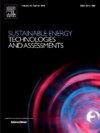甲醇浓度对低压缩比下废炒油-生物柴油-甲醇-柴油三元混合燃料单缸柴油机燃烧及声振特性的影响
IF 7
2区 工程技术
Q1 ENERGY & FUELS
Sustainable Energy Technologies and Assessments
Pub Date : 2025-06-12
DOI:10.1016/j.seta.2025.104403
引用次数: 0
摘要
许多研究探索了三元燃料混合物的性能、排放和燃烧特性;然而,对三元混合燃料发动机的噪声和振动水平的研究还不多。因此,在本研究中,在单缸柴油机上,探讨了三元燃料混合物(废油炸油生物柴油(B)-柴油(D)-甲醇(M))中甲醇浓度对燃烧和振动声行为的影响。通过改变生物柴油和甲醇的比例制备了三种三元共混物。实验是在较低的压缩比为17:1的情况下,通过改变发动机负荷进行的。振动声学测量是使用气缸盖上的三轴加速度计和两个麦克风进行的。与柴油相比,含10%和30%甲醇的三元混合物在峰值负荷下分别使汽缸压力增加了3.46%和3.38%。在中等负荷下,10%和20%甲醇混合物的缸压分别高出4.1%和1.23%。具有较高甲醇浓度的三元共混物显著提高了压力上升速率。B20M30D50、B30M20D50和B40M10D50的RoPR分别提高了5.81%、13.103%和5.66%。甲醇浓度超过10%会增加所有加速度计方向上的加速度振幅。在进气和排气歧管附近观察到较高的噪声压力水平,可能是由于它们靠近流体引起的噪声源。本文章由计算机程序翻译,如有差异,请以英文原文为准。

Effect of methanol concentration on combustion and vibro-acoustic behaviour of a single-cylinder diesel engine fuelled with waste fried oil biodiesel-methanol-diesel ternary fuel blends at lower compression ratio
Many studies explored the performance, emission, and combustion characteristics of the ternary fuel blends; however, the noise and vibration levels of the engine fueled with ternary fuel blends are not much explored. So, in this study, the influence of methanol concentration in ternary fuel blends (waste fried oil biodiesel (B)-diesel (D)-methanol (M)) on combustion and vibro-acoustic behavior is explored in a single-cylinder diesel engine. Three ternary blends were prepared by varying biodiesel and methanol ratios. The experiments are carried out by varying the engine load at a lower compression ratio of 17:1. Vibro-acoustic measurements were taken using a triaxial accelerometer on the cylinder head and two microphones. Ternary blends with 10% and 30% methanol increased cylinder pressure by 3.46% and 3.38% at peak load, respectively, compared to diesel. At mid-load, 10% and 20% methanol blends exhibited 4.1% and 1.23% higher cylinder pressure. Ternary blends with higher methanol concentrations significantly increased the rate of pressure rise. B20M30D50, B30M20D50, and B40M10D50 showed RoPR increases of 5.81%, 13.103%, and 5.66%, respectively. Methanol concentrations above 10% increased acceleration amplitudes across all accelerometer directions. Higher noise pressure levels were observed near the intake and exhaust manifolds, likely due to their proximity to fluid-induced noise sources.
求助全文
通过发布文献求助,成功后即可免费获取论文全文。
去求助
来源期刊

Sustainable Energy Technologies and Assessments
Energy-Renewable Energy, Sustainability and the Environment
CiteScore
12.70
自引率
12.50%
发文量
1091
期刊介绍:
Encouraging a transition to a sustainable energy future is imperative for our world. Technologies that enable this shift in various sectors like transportation, heating, and power systems are of utmost importance. Sustainable Energy Technologies and Assessments welcomes papers focusing on a range of aspects and levels of technological advancements in energy generation and utilization. The aim is to reduce the negative environmental impact associated with energy production and consumption, spanning from laboratory experiments to real-world applications in the commercial sector.
 求助内容:
求助内容: 应助结果提醒方式:
应助结果提醒方式:


